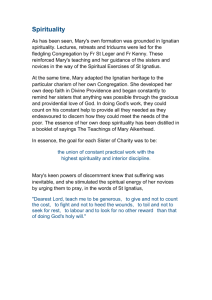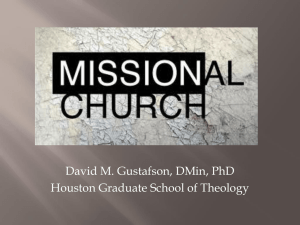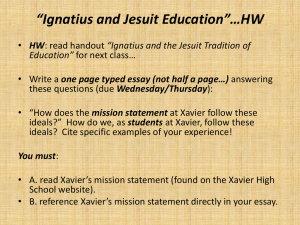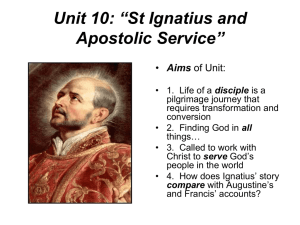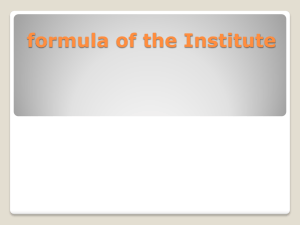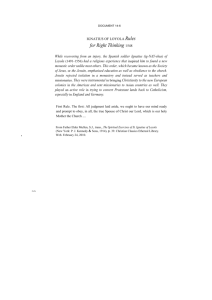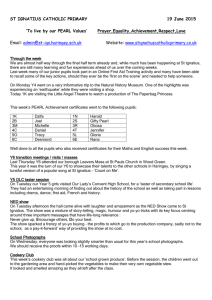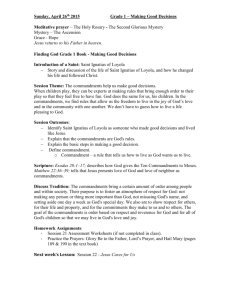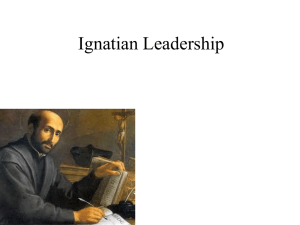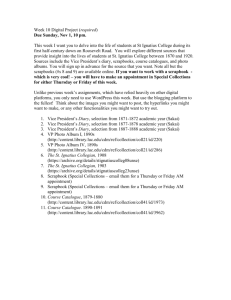we are of the societ we are of the societ we are of
advertisement
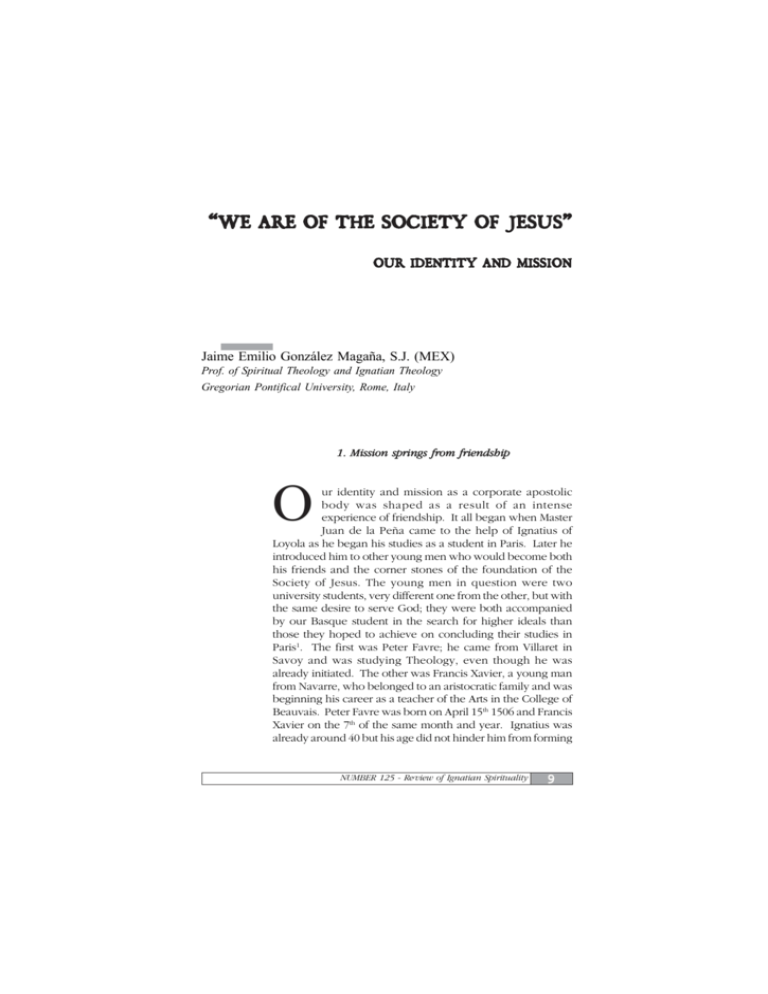
“WE ARE OF THE SOCIET Y OF JESUS” SOCIETY OUR IDENTIT Y AND MISSION IDENTITY Jaime Emilio González Magaña, S.J. (MEX) Prof. of Spiritual Theology and Ignatian Theology Gregorian Pontifical University, Rome, Italy 1. Mission springs from friendship ur identity and mission as a corporate apostolic body was shaped as a result of an intense experience of friendship. It all began when Master Juan de la Peña came to the help of Ignatius of Loyola as he began his studies as a student in Paris. Later he introduced him to other young men who would become both his friends and the corner stones of the foundation of the Society of Jesus. The young men in question were two university students, very different one from the other, but with the same desire to serve God; they were both accompanied by our Basque student in the search for higher ideals than those they hoped to achieve on concluding their studies in Paris1. The first was Peter Favre; he came from Villaret in Savoy and was studying Theology, even though he was already initiated. The other was Francis Xavier, a young man from Navarre, who belonged to an aristocratic family and was beginning his career as a teacher of the Arts in the College of Beauvais. Peter Favre was born on April 15th 1506 and Francis Xavier on the 7th of the same month and year. Ignatius was already around 40 but his age did not hinder him from forming O NUMBER 125 - Review of Ignatian Spirituality 9 “WE ARE OF THE SOCIETY OF JESUS” an authentic friendship with those young people whom he would lead by the hand in the search for the identity and mission of what would be a different Religious Order. Ignatius was “affable and kind, he conversed easily with the young men, he was as sparing as he was rich; he was a man who had been around, even if on the whole he was not a talkative person especially when there was no subject of special interest; he was especially reserved with Xavier. He did not know how far Loyola had been involved with the Duke of Nájera...”2. Very soon he realised that his room mates were young men with extraordinary capacities and “he began to win them over with his ingenuity and excellent doctrine”3. He never let slip any opportunity of making them his friends in the Lord and began his dialogues with Peter Favre, “with whom he struck up a very close friendship, [although] at the start he did not pull out all the stops nor try his best to gain this soul in one go, but rather proceeded very cautiously and slowly with him” 4. His relationship with Francis Xavier began by being more difficult as the aristocrat from Navarre had no confidence in him and “showed little inclination to follow him, at least to begin with”. Dr. Juan de Jasso’s son remembered that the Loyola family had belonged to the enemy band and far from supporting the Albret dynasty, the legitimate rulers of Navarre, in their hopes of regaining the throne, they supported the Castilian rulers in their thirst for expansion and conquest. There was something else, apart from the immediate and mutual liking that sprang up between Ignatius and Favre, and that was that Master Peña realised that whatever good intentions Ignatius had with regard to his studies, he would find them a great burden and need help. It occurred to him that if another student were to help him, things would be easier and decided to invite Favre to carry out this task. Favre has left us proof of his friendship in his Memories where he writes: “This year (1529) Ignatius came to live in the same College, St. Barbara’s, and shared a room with us; he hoped to enrol in San Remigio to study Arts. The above mentioned Master (this refers to Favre himself) would look after him. May Divine Providence who so willed it for my good and my salvation be forever blessed”5. Ignatius was convinced that studying had to be his first priority so, together with Favre, they arrived at the conclusion “that they would not talk about God during the time dedicated to study; because if they started a discussion or spiritual conversation they would be so carried away by the heavenly breeze that blew on them, they would spend hours without being 10 Review of Ignatian Spirituality - XLI, 3/2010 Jaime Emilio González Magaña able to go back to their books and so be unable to benefit from their studies”6. Ignatius chose to sit his final exam in Santa Genoveva, where he came 30th and considering that between 90 and 100 students sat that exam, we could say his results were above average. Francis Xavier came 2nd and Favre 24th.7 Any Graduate who passed this exam could teach the Arts or Philosophy anywhere in the world8. At the same time Ignatius was going over the notes he had made in Manresa – fruit of his mystical experiences – and incorporating his more recent experiences. He had already made some attempt to share these experiences with some of the students at Alcalá, but he was not yet thinking of using them as an apostolic aid. His stay in Paris, his contact with the intellectual and religious world, would help him to shape the Spiritual Exercises into something that would evangelise and motivate others in their decision to search for, find and hear the will of God. In Alcalá and Salamanca, Ignatius had been in close contact with the trends, both good and bad, of the Age of Enlightenment; in Paris he saw that the influence of Erasmus of Rotterdam was very great and that Martin Luther’s way of thinking was becoming deeply rooted in the minds of many students and high ranking, prestigious professors, both in learned university circles and throughout France in general9. Never before as in Paris did Ignatius realise how much the people of God hungered and thirsted for conversion. And this was true not only at the level of young university students but also among the clergy and all levels of society. In an atmosphere that was controversial, suspicious, filled with doubt and unrestrained aggression, Ignatius knew intuitively that the Spiritual Exercises, as a valued with the Spiritual Exercises in gift from the Lord, could be a powerful way of contributing to his hands and eyes fixed firmly an authentic conversion that on the Lord and on the future, would lead to a return to God and his values he began to spread his love The sorrow that Ignatius and interior strength to other felt at the continuous attacks on Parisian students the See of Peter and on many of the beliefs traditionally taught to the people, led him to write the Rules on the true attitude of mind that we ought to have in the Church militant, with the intention of communicating, in simple, clear language, his love of, and absolute and unbreakable obedience to, “our holy Mother, NUMBER 125 - Review of Ignatian Spirituality 11 “WE ARE OF THE SOCIETY OF JESUS” the hierarchical Church, the Church of Rome”10. In doing this he not only struck an important blow against Lutheranism but also counteracted the bitterness of Erasmus with such force that, with the Spiritual Exercises in his hands and eyes fixed firmly on the Lord and on the future, he began to spread his love and interior strength to other Parisian students11. He personally gave the Spiritual Exercises to each one of his companions, quietly and discreetly. None of them spoke to the others12 and so, silently, simply – in the same way that God acts when things are really important – those young men, dreamers like their spiritual companion, began to believe in the utopia of working together as companions in the common mission of preaching in poverty, like Christ, and of sharing their education, youth and ideals in search of the great Ideal they shared in Jesus of Nazareth. The Parisian students who joined this utopia of Ignatius of Loyola were Peter Favre, Francis Xavier, Diego Laínez, Alphonso Salmeron, Simon Rodrigues and Nicholas de Bobadilla. Later, Claude Jay, Pascase Broet and Jean Coduri would follow. 2. Friends in the Lord at the service of the Church The first companions made the Spiritual Exercises and decided to join Ignatius in his proposal to go to the Holy Land and dedicate his life to the service of souls. They were all familiar with an ancient, solitary church that rose some 600 metres from the summit of Montmartre: Our Lady of Montmartre or the Holy Martyrs so named because of an old tradition that St. Denis and his companions, Rustico and Eleuterio, had shed their blood there for Christ. They decided they would make their vows there on August 15th 1534; vows of Poverty, Chastity and to make a pilgrimage to Jerusalem. They had planned to begin their pilgrimage a little later. In spite of the students’ fervent desire to begin their mission, it had to be postponed as, due to the poor state of Ignatius’ health, the doctors ordered him to return to his native land to recuperate. We know that, after his visit to his family and his country men in Azpeitia, he planned to visit the families of his companions, settle outstanding, important issues with various people and contact some old Parisian students. Then he intended going to the University of Bologna to continue his interrupted studies. He passed by Obanos, 22 kilometres from Pamplona, to meet Francis Xavier’s brother, Don Juan de Azpilcueta, and to deliver, in person, a letter from the young man from 12 Review of Ignatian Spirituality - XLI, 3/2010 Jaime Emilio González Magaña Navarre. He also went to Almazan, to meet Diego Laínez’ family; he then visited Siguenza; his motive for doing this is not clear, but it is thought he wished to visit a student he could have met in Paris. Ignatius did not let up in his efforts to invite others to form part of the group of companions and to this end he stopped off in Madrid. Everything indicates that he met the heir to the throne, the future Philip II, at the court in Madrid, thanks to Doña Leonor de Mascareñas, with whom he had made friends during his stay in Alcalá de Henares. The son of Charles I of Spain and V of Germany would have been 9 at the time and would later remember Ignatius when the artist Alonso Sánchez Coello presented him with a picture of the Saint in 1587; he remarked, “It’s a very good likeness. I met Fr. Ignatius and this is his face; though when I knew him, he had a larger beard” 13. Fr. José Acosta acknowledged that when Philip II received him in 1594 he “told him that he had met Fr. Ignatius in Madrid”14. Ignatius then went to Toledo as he wished to visit Canon Pedro de Peralta whom he had met in Paris and who, while never joining the Society of Jesus, always remembered this surprising student with special affection. Likewise, he visited Alphonso Salmeron’s family and, around September, made his way to Valencia because he wanted to see Don Juan de Castro whose love for the contemplative Carthusian life prevented him from following the plans of his friend Ignatius. It was from this city that he set sail for Geneva towards the middle of November15. On arrival there, “he set out for Bologna, and met a lot of problems on the way; the worst was when he got lost and started to walk on a path alongside, but high above, a river. The further he walked along this path the narrower it became until it was so narrow he could neither advance nor return; he then had to crawl on his hands and knees for a good stretch of the path, frightened that with every step he would fall into the river. This was the worst physical trial he had to endure but he finally got through it. Then when he came to enter Bologna he found he had to cross a small wooden bridge, but he fell underneath it and made all those who were round about laugh when he got up covered in mud. Once inside Bologna he began to beg, but he didn’t get a penny even though he went round the whole city16. However our pilgrim soon forgot the poor hospitality of this Italian city when Don Pedro Rodríguez de la Fuente offered him accommodation in the distinguished Spanish College of St. Clement17 where he was rector. He intended to use the money given him by his friend Isabel Roser to finish his theological studies there while awaiting his companions who had remained NUMBER 125 - Review of Ignatian Spirituality 13 “WE ARE OF THE SOCIETY OF JESUS” in Paris to finish their studies18. However in spite of Don Pedro’s warm welcome his wishes were not going to be fulfilled and once again he had to change his plans. The city’s foggy climate did not suit him and he decided to leave for Venice “always in the same way”. There he would wait for his companions who would arrive at the beginning of 1537 as had been agreed19. We are not sure who the “good, learned man” was who kindly offered lodging to our pilgrim student. Some have thought it was Pedro Contarini, bursar of the hospital for incurables. Others say it was Martín Zornosa, Charles V’s Consul in Venice and yet others say it was Andrés Lipomani who, “without being a learned man was a man of letters whom few could equal for goodness and humility20” and who a short time before, in 1534, had welcomed to the hospital Jerome Emiliani, the founder of the Order of Somascha, a man well known for his work for the poor, for orphans, the abandoned, those who had incurable illnesses and repentant sinners. Ignatius renewed his theological studies determined to comply with the four years required of him if he wanted to be able to teach “legitimately”. Of the nineteen months he stayed in Venice – from January 1536 to July 1537 – we only have a few lines from his Autobiography in which, with his exquisite brevity, he simply tells us that “he spent the time giving the Exercises and other spiritual conversations”. We know he gave the Exercises to two distinguished people, Master Pedro Contarini, bursar of the hospital for incurables and Master Gaspar de Doctis, the Pontifical Nuncio in Venice. Gaspar took simple vows in the Society in 1556 but remained in charge of the Sanctuary of Loreto. There seems to have been a third one, someone by the name of Rodrigo Rozas, about whom we know very little. Another was Diego de Hoces from Malaga who, once he had overcome his doubts as to the orthodoxy of the Exercises, made them with great generosity and dedication and ended up joining the group of the first companions; “he was the first to die” in Padua 153821. The first companions were due to arrive at the beginning of 1537, however, the fortunes of the war between Francis I, King of France and the Emperor Charles V of Germany, obliged them to set out on November 15th 1536; therefore the arrival in Venice was brought forward. Ignatius had been in the city throughout 1536 dedicated mainly to studying Theology privately as there was no University in Venice, the nearest being in Padua. He revised the books he had used in Paris, Peter Lombard’s Sententiae and probably the Summa Theologica or other partial commentaries recommended to him by the Dominicans of Saint Jacques. He also had the 14 Review of Ignatian Spirituality - XLI, 3/2010 Jaime Emilio González Magaña books lent to him by his friend and protector Andrés Lipomani who, as the Prior of the Holy Trinity, had a good library at his disposal22. While he was studying he continued giving the Exercises, as well as taking the opportunity to correct the text and above all he never lost contact with the poor and the needy. The companions finally arrived in Venice on January 8th 1537 and found Ignatius “with joy in their hearts23” and with the same affection and friendship which kept them united. Three new young theology students had joined the group as a result of the Spiritual Exercises and Peter Favre, who had been in charge of the group in Paris, introduced them to Ignatius. They were Claude Jay, Pascase Broët and Jean Coduri24. In turn, Ignatius introduced Diego de Hoces and the brothers Diego and Esteban de Eguía who had shown interest in joining the group of pilgrims. Antonio Arias y Miguel Landívar, for whom ordination had been sought in Rome, had also joined them. However on returning from Rome to Venice, they left the group. One more companion, Lorenzo García, would join them in Rome but in like manner, would in Venice, the group of the leave them after a short while, first companions lived a frightened by the persecutions the decisive and very important companions had to suffer25. In Venice, the group of the stage on the road to the first companions lived a decisive foundation of the Society of and very important stage on the road to the foundation of the Jesus and the definition of its Society of Jesus and the definition identity and mission of its identity and mission. The first community experienced a series of events that would unite them even more and help them to outline what they wanted to be and do in the future. I refer to their priestly ordination, their first Masses, the beginning of their apostolic and missionary activity, the first community discussions about their future and finally the decision to go to Rome when their plans to go to Jerusalem finally ended in failure26. All the companions talked of their cherished dream of going on pilgrimage to the Holy Land, but the boats would not set sail till after Pentecost which meant a wait of almost 6 months. In the meantime they decided to dedicate themselves to the service of the poorest of the poor in the hospitals. Favre, Xavier, Laínez and two others went to the Hospital for Incurables27. Diego de Hoces, Rodrigues y Salmerón NUMBER 125 - Review of Ignatian Spirituality 15 “WE ARE OF THE SOCIETY OF JESUS” with another two went to John and Paul’s Hospital. The priests, Favre and Hoces, heard the confessions of the sick and gave them all kinds of spiritual help; the others, who had not yet been ordained, dedicated themselves to lesser, more humble tasks, their first steps in the apostolic experiences required of any candidate wishing to be a Jesuit28. Ignatius continued his studies because he wanted to finish as soon as possible and so meet the requirements of the ecclesiastical authorities. He already possessed a certificate in theological studies dated October 14th 1536, just before his companions left for Italy. It was a record of the studies he had completed, however he was aware that he had to comply with the judgement given in Alcalá in 1527, which obliged him to complete the four year cycle29. The document had been issued by the Dean and the Professors of the Faculty of Theology of Paris and stated very clearly that “the Bachelor of Arts has been a student of Theology”, and added, for those for whom certificates were important: “to whom it may concern to-day or in the future, we hereby declare, that the undersigned Master Ignatius of Loyola has studied in this faculty for a year and a half . . . . Given in Paris, apud Sanctum Mathurinum, October 14th 1536”. The Diploma was not enough. Ignatius had started his studies in Paris at the beginning of 1533 and carried on till April 1535, that is for almost two years. Later he studied in Venice from the end of December 1535 till March 1537 inclusive, as well as the classes with the Dominicans and Franciscans in Paris. In this way he would comply with the legal judgment given in Alcalá and in Salamanca when he had been in prison by order of the Inquisition. Time was passing and the companions began to prepare for their journey to Rome to seek the permissions they needed for their journey to Jerusalem as well as the dispensations to allow those who were not yet priests to be ordained “outside the scheduled times and by any bishop”30. They returned to Venice in May 1537 with good news: the Pope had not only granted them permission to make their pilgrimage to Jerusalem31 but also the licences for ordination, the only condition being that Salmerón, who at the time was only 23, should wait a little before being ordained32. The document referring to Ignatius’ ordination stated: “Vicente Nagusanti, . . . . Bishop of Arbe (now Rab) informs everyone who sees this document, that our dear son in Christ Ignatius Loyola, bachelor of the liberal arts. . . according to the dispensation given by the apostolic Penitentiary. . .” then follows a copy of the document given by Cardinal A. Pucci, after which it continues: “received the Four Minor Orders on Sunday the 10th day of June; 16 Review of Ignatian Spirituality - XLI, 3/2010 Jaime Emilio González Magaña the order of Sub-Deacon on the feast of SS. Vitus and Modestus, which was a solemnity in this city of Venice, that is the 15th day; the order of Deacon on the 17th day, which was Sunday; and the order of priest on the feast of St. John the Baptist, according to the rites of the Church of Rome. This was done canonically during the solemnity of the Mass, in a pontifical celebration in the chapel of the house of the Ordinary of Venice; we decided to promote him and we did so on finding him suitable and competent because of his level of knowledge and his voluntary poverty, and authorised by the most Reverend Don Jerónimo Verallo . . . in whose hands the said Ignatius of Loyola made a vow of perpetual poverty. Given in Venice, in the chapel of our dwelling in the year 1537 on the 27th day of the month of June”33. Peter Favre, Diego de Hoces and Antonio Arias, who were already priests, also obtained faculties to hear the confessions of all the faithful and to give them absolution for all sins reserved to bishops34. Nicholas de Bobadilla, Diego Laínez, Francis Xavier, Jean Coduri, Simón Rodrigues and Miguel Landívar are also mentioned in the document. Ignatius was satisfied. He had finally received permission to preach in public and in private. He had fought hard, tenaciously, humbly, simply, but also in defence of what, in all conscience, he believed before God. Alone and confused when he began, he now found himself with “nine of my friends in the Lord, all Bachelors of Art and highly skilled in theology, four of them were Spanish, two French, two from Savoy and one from Portugal. . . and a few others who wished to follow the same ideals. . .”35 He shared this happiness, fruit of his interior freedom and complete openness to the will of God, with his friend and benefactor, Mosén Juan de Verdolay. The Church, in the person of the Bishop of Arbe, Vicenzo Nagusanti, had finally received him and his companions as poor and reformed priests. The Bishop said “that never in his life had he celebrated an ordination with such great consolation”36. 3. We belong to the Society of Jesus Ignatius’ joy and confidence were clearly seen in the letter he wrote on July 24th 1537 to Mosén Juan de Verdolay, a man from Aragon who was well-known in Catalonia and Valencia37. In it his gratitude and optimism are evident scarcely a month after his ordination as a priest. Ignatius wanted his friend to join the group but this did not happen until November 9th 1556, the date on which he applied to enter the Society; he was received a month NUMBER 125 - Review of Ignatian Spirituality 17 “WE ARE OF THE SOCIETY OF JESUS” later, on December 6th at the College in Valencia38. After a prolonged delay in accepting him for final profession Fr. Araoz wrote to Laínez on January 30th 1564 to say that Mosén Juan de Verdolay left the Society and entered the Carthusians. According to Polanco his departure was because of a “lack of resignation of spirit”39. Meanwhile rumours of a war against the Turks were ever more frequent in the city of Venice so the new priests decided to continue their work of helping souls. They re-enforced their dedication to the apostolate and stood out for their availability, their mobility and their apostolic initiatives. Their service to the poor in the hospitals was most edifying, they lived by begging and spent a lot of time preaching, but this meant that they had little time to prepare for the celebration of their first Mass so they “agreed to leave Venice, but not the diocese, and go to different places: M. Ignatius with M. Favre and M. Laynez to Vicentia, M. Francis and M. Salmerón to Moncelese, M. Coduri and B. Hozes to Treviso, M. Claudio and M. Simón to Bassán, M. Pascasio and M. Bobadilla to Verona. Apart from preparing for their first Mass, they intended to beg and to preach with little or no study and in the plazas. . . .40”. Later Ignatius called the companions to Vicenza to discuss recent events. From St. Peter of Vivarolo this group of apostles radiated a new way of life which was so refreshing and different from anything that had been seen before. The people were witnesses to the the people were witnesses to affection which the companions had one another, the friendship which the affection which the for strengthened them and helped them in companions had for one their daily apostolic ministry, they saw another, the friendship how they preached in poverty, how they continually communicated with which strengthened them one another and, above all, how they and helped them in their made great efforts to discern and be to God’s will. Their daily apostolic ministry attentive discussions led them to decide, at the end of September, that Francis Xavier, Diego Laínez, Nicholas Bobadilla and Jean Coduri would celebrate their first Mass. Rodrigues celebrated it later in Ferrara41 and Salmerón, as we have already stated, had not yet been ordained. Ignatius did not celebrate his, since “he had decided that after ordination he would not say Mass for a year while he prepared himself and 18 Review of Ignatian Spirituality - XLI, 3/2010 Jaime Emilio González Magaña besought the Virgin to set him with her Son42”. The discussions continued, resulting in the companions taking another very important decision for the life and future of the Society of Jesus: they would seek out young students in the Universities with the intention of attracting them to their newly formed group43. In Vicenza yet another significant decision was taken: they decided that when asked who they were, they would reply: “We are the Society of Jesus” because they had no doubt that the only head of their group was Christ; this name had been confirmed to Ignatius on various occasions in supernatural visions and they had adopted it after serious discernment among all the companions44. A new element which would become a determining factor in the decisions they were to take was the entry of the Republic of Venice into the League of the Emperor and the Pope against the Turks. To begin with it made the journey to Jerusalem, which they had decided on in Paris, practically impossible. Later, having waited a year for a boat, they decided to go to Rome to carry out their dedication to the Pope as they had promised in the vows taken in Montmartre on August 15th 1534. While the companions were working tirelessly in various Italian cities Ignatius, Favre and Laínez set out for Rome to pave the way for the future apostolate of the group. On the way, Ignatius received a clear signal that the decision he and his companions had taken was the correct one. Our pilgrim was convinced that the Eternal City would be another Jerusalem for them and that their mission would continue in the capital of Christianity. Ignatius tells us that, “ . . .one day when he was still some miles from Rome, while praying in a church he felt such a transformation in his soul and saw so clearly that God put him with Christ, his Son, that he could not doubt this and that God really was putting him with His Son”45. Diego Laínez, the second Superior General tells us that: “. . . he told me that God seemed to have printed these words on his heart; Ego ero vobis Romae propitius: I will be favourable to you in Rome. And since our Father did not know what was meant by this, he said: I do not know what will happen to us; perhaps we will be crucified in Rome. . .” Again he said that he seemed to see Christ carrying his cross and beside Him the Eternal Father who said, I want you my Son to take this man as your servant. So Jesus took him and said: I want you to serve us. And so because of this he had a great devotion to this Holy Name and wanted the congregation to be called the SOCIETY OF JESUS”46. Confirmation from “on high” kept on arriving; Ignatius’ work and that of the university students was pleasing to God, in spite of this, and as a NUMBER 125 - Review of Ignatian Spirituality 19 “WE ARE OF THE SOCIETY OF JESUS” sign and further proof that the work was signed by Christ’s cross, the “reformed priests”, the “pilgrim priests,” aroused envy here “below” because of their evangelical preaching, the giving of the Spiritual Exercises, or for their closeness to the Pope who frequently invited them to debate with University professors during meals47. The difficulties increased when the Cardinal Legate, Vicente Carafa, granted them full faculties to carry out their ministry, in such a generous way that Ignatius described it as an “abundant licence48”. It authorised them to preach freely throughout the city, to hear the confessions of all the faithful, to absolve sins reserved to bishops and to administer the sacraments, always with the consent of the parish priests. So many favours and positive comments motivated an investigation into the life and doctrine of Ignatius and his companions. This investigation was brought about as a result of the accusations made by an Augustinian Friar by the name of Agustin Mainardi against Ignatius and his companions. Mainardi, taking advantage of the fact that Pope Paul III had left Rome to try and re-establish peace between Francis I of France and Charles I of Spain and V of Germany, preached some sermons of a highly Lutheran flavour in St. Augustine’s Church in Rome. As Favre and Laínez had heard him and had taken it upon themselves to expose his deceptions, the Augustinian, supported by Francisco Mudarra, Pedro Castilla and Mateo Pascual – all well known for their zeal in seeking benefits – dedicated themselves to attacking the companions by spreading rumours and calumnies to discredit them before the people who were listening to them with ever increasing attention. The first accusation was aimed at Ignatius who, according to them, had been condemned as a heretic in Spain, in France and in Italy. They maintained that the only reason he had come to Rome was because he was fleeing from the Holy Inquisition. This campaign was supported by Miguel Landívar, an old friend of Ignatius and Francis Xavier and who, apparently had found “better feeding grounds” to calm his hunger and thirst for privileges and favours than those of the new, poverty stricken Society49. It was a high risk situation precisely because the first companions were close to the Pope and had already begun their apostolic ministry. When they could not persuade their principal accusers to retract their calumnies, Iñigo made a formal complaint. The detractors, realising the law would expose them, began to lavish fulsome praise on those whom they had formerly accused of heresy. Ignatius took the case directly to the Pope and asked him to settle matters by a public declaration. He had not been afraid of lower authorities before and he was certainly not going to be afraid now 20 Review of Ignatian Spirituality - XLI, 3/2010 Jaime Emilio González Magaña when he knew that the highest ecclesiastical authority could destroy the envy which lay at the root of all this confusion and suffering. Testimonies from various well known people, among whom were those who had examined Ignatius when he had appeared before the tribunal on previous occasions, Don Juan Rodríguez Figueroa in Alcalá; Pedro Ortíz and Francisco Mateo Ory in Paris and Gaspar de Doctis in Venice, led the ecclesiastical hierarchy to deliver a verdict of not guilty, proving irrefutably that their doctrine was “evangelical, holy and good” and that they had continually attacked Luther’s doctrines, thus showing themselves always faithful to the Roman Catholic Church. Also among the judges was the cleric Amelia Doimo Nascio, the Ambassador from the Seine in Rome, Lattancio Tolomei and Doctor Fernando Díez from Carrión50. Ignatius demanded that the Governor Conversini should dictate the formal verdict in his favour and that of his companions. In the Governor of Rome’s verdict Ignatius and his companions are mentioned as the “Masters of Paris.51” Faced with such persistence from Ignatius, who was determined not to have any setbacks in Rome, the Governor signed the verdict of not guilty on November 18th 1538. There was now nothing to prevent the Masters of Paris from fulfilling their offering to the Pope nor any reason why Ignatius should not celebrate his first Mass. Coverini’s verdict of not guilty brought their waiting to an end. The time had also come for the group of companions to go to the Pope and put themselves at his disposal. A short time previously, two of them had dined with the Holy Father and had surprised him with their wisdom and simplicity. It was the right moment for the whole group to go and prostrate themselves at the feet of the Roman Pontiff as the Vicar of Christ on earth. They wanted to dedicate their whole lives to Christ through his servant, hoping and trusting that their offering would be pleasing and useful in extending his vineyard throughout the whole world, going wherever he sent them. We do not know the exact date of their audience with Pope Paul III, but it is thought that it took place before November 23rd, a short time after the declaration of the not guilty verdict. They fulfilled the promises made in Paris and offered themselves freely to the Vicar of Christ for him to determine where to send them52. Paul III not only accepted them, he gave the group a character of universal service and, aware of their preparation and their decision to serve the Church, the true Spouse of Christ, he asked them to remain in Rome and give their long-dreamt-of Greater Glory to God there. Very soon they would see that God had more ambitious and truly universal missions waiting for them; bishops of different dioceses, NUMBER 125 - Review of Ignatian Spirituality 21 “WE ARE OF THE SOCIETY OF JESUS” princes and ambassadors from Christian kingdoms began to request the services of those poor, learned, reformed priests to give new life to their people dazed and drugged by Protestant doctrines. The companions and friends in the Lord were about to scatter, thus giving the group a nuance they had not thought about nor even imagined. In this way the foundations were laid for the emergence of the Society of Jesus as a Religious Order at the service of the Universal Church. Ignatius, for his part, acknowledged and gave thanks for so many gifts received and, among them, he confirmed another decision: seeing that Divine Providence had determined that they should not return to the Holy Land where he had dreamt of celebrating his first Mass, specifically in Bethlehem, he arranged to do this in the place where popular belief and Christian tradition venerated “the relics of the crib where Christ was born”, in the basilica of St. Mary Major53. 4. On mission to the whole world, under the standard of the cross, in poverty and humility, for the salvation of souls The gentleman who had left Loyola in search of his own vocation, suddenly found himself involved in the urgent business of giving a formal structure to that small group of friends in the Lord. While he was surprised at what God was gradually revealing to them, it was necessary to discern what was most conducive to the preservation of the body He had entrusted to him. And, for the hundredth time he asked himself, quid agendum? they all agreed that they what’s to be done? So around Lent wanted to form a stable body 1539 the companions began another kind of discussion, aimed which would remain united at determining the structure of the even if the Pope sent them to Society of Jesus; they ended in June the same year. They all agreed different parts of the world of that they wanted to form a stable body which would remain united even if the Pope sent them to different parts of the world. They also wanted to invite others to share their life; they longed to arouse vocations which would increase the size of that body which the Lord had brought to birth. Their words were: “In the end we established the affirmative side of the question, that is, that in as much 22 Review of Ignatian Spirituality - XLI, 3/2010 Jaime Emilio González Magaña as our most kind and affectionate Lord had deigned to gather us together and unite us, men so spiritually weak and from such diverse geographical and cultural backgrounds, we ought not split apart what God has gathered and united; on the contrary, we ought day by day to strengthen and stabilise our union, rendering ourselves one body with special concern for each other, in order to effect the greater spiritual good of our fellow men. For united spiritual strength is more robust and braver in any arduous enterprise than it would be if segmented” 54. So they would seek approbation from the Holy See for the foundation of a new Religious Order. In Montserrat they had not taken a vow of Obedience. And, although in fact since Vicenza they had obeyed Ignatius because of his natural qualities of leadership, they realised that they needed to clarify what such a vow would imply. They had to decide whether to make this vow to one of themselves, “in order that we might more sincerely and with greater praise and merit be able to fulfill the will of God in all details of our lives as well as in carrying out the authoritative decision of the Pope, to whom we have most willingly offered our all, will, intellect, strength,” 55. And “ not just with a majority judgement but without a single dissenting voice, come to the conclusion:: Obedience to someone among us highly advantageous and highly necessary in order to actualise more effectively and exactly our primary desire of fulfilling God’s will in al details of life, in order to preserve the Society more assuredly, and finally in order to provide properly for all the detailed matters of spiritual and temporal business which arise” 56. There were other important issues that it was imperative they define: the profession of a special vote of obedience to the Roman Pontiff, the way to teach Catechism to children and the lifelong tenure of the Superior General. All these issues had to be examined, discussed and approved in the deliberations of 1539 which were decisive in the history of the Institute of the Society of Jesus. Ignatius with his secretaries – at that time Fr. Francis Xavier was the secretary of the Society – helped by other willing volunteers, drew up, by way of a “Summary”, a plan which was to contain a Formula for the Institute57. On September 3rd they received, through Cardinal Gaspar Contarini, papal approbation for the first draft made in August 1539 in which they were addressed as “the beloved sons of Ignatius of Loyola. . . Masters of Paris. . .” The document would have to be revised, more so as the intention was that it should be a Bull. Ignatius saw one of his most cherished dreams finally fulfilled when the Bull Regimini militantis Ecclesiae, signed by Paul III, was issued on September 27th 1540 by which the Institute of the NUMBER 125 - Review of Ignatian Spirituality 23 “WE ARE OF THE SOCIETY OF JESUS” Society of Jesus received solemn and public approbation58. This Bull outlined the central aspects of the new Religious Order. Even so order and structure had still to be given to this new body so that the spirit and life that the group of ten companions had shaped could be organised. The first step in this organisation was the decision concerning the naming of a Superior General. At that time Jean Coduri, Alfonso Salmerón and Ignatius himself were the only ones in Rome. Peter Favre was in Germany with Doctor Ortíz. Francis Xavier and Simón Rodrigues were in Portugal. Nicolás de Bobadilla was in Calabria where he was acting as Vicar General in place of Cardinal Bembo. Diego Laínez, Pascase Broët and Claude Jay arrived in Rome during Lent 1541. Pope Paul III issued the second Bull Sacrosantae Romanae Ecclesiae and on March 4th the companions met to begin the process of writing the Constitutions as had been stipulated in the Formula. The six who were present decided – with the authorisation of those who were absent – that Jean Coduri and Ignatius of Loyola should draw up the Constitutions of 1541, though these would not be definitive. Their mission was to perfect the Deliberations and the Conclusions of 1539, placing special emphasis on poverty, clothing, footwear, the teaching of Christian doctrine, the admission of candidates and their experiences, as well as some initial rules for internal discipline. The only thing left out was the election of a Superior. Once again Ignatius was keeping watch to make sure that all went well in this matter which was so vital to the newly formed Order and he drew up the document Form of the Society and offering59 which lays down the process followed in the election and the offering of the Society, and so completed what was missing. In all probability the process for the election of the Superior General was begun around April 2nd. Following the same method which had given them such good results in the deliberations of 1539, they began with a 3-day period of prayer in absolute silence so that no-one could influence anyone else in such an important matter60. At the end of the three days they came together, each one with their vote written down and sealed “so that each one could speak more freely and make their will known.61” They collected their own papers and those their companions in Portugal and Germany had sent, then, to give anyone who wished to do so an opportunity to change their mind and “for greater confirmation,” they placed them all in a chest under lock and key. The election process ended on April 8th, the Friday of Passion week, and “opening all the documents, one after the other, without a single dissenting voice, all the votes fell on Iñigo, with the exception of Master Bobadilla (he was in Bisignano and just 24 Review of Ignatian Spirituality - XLI, 3/2010 Jaime Emilio González Magaña as he was about to set out for Rome was ordered by the Pope to stay there) who did not vote for anyone”62 Ignatius expressed his reluctance to accept the office and asked them to pray about it for three of four days more “and although it was not really what the companions wanted, that is how it ended”63. Because of the circumstances the election was repeated on April 13th with the same results as before. Once again Ignatius repeated that he did not believe himself qualified to occupy this office and after placing the matter in the hands of his confessor, the Franciscan, Fr. Theodosio, Ignatius humbly realised that he could not resist the Holy Spirit so clearly manifest in the wishes of his companions and on April 19th he agreed to become the first Superior General of the Society of Jesus. That same Easter Tuesday the resolution was taken that “Iñigo should assume the affairs and government of the Society”. Finally on April 22nd, the on April 22nd, the Friday of Friday of Easter week, the six Easter week, the six companions went to the Basilica of St. Paul outside the Walls, they companions went to the heard one another’s confessions, Basilica of St. Paul outside the then by common consent Ignatius Walls, they heard one celebrated Mass so that they could all receive Communion from him another’s confessions, then by and, having renovated their common consent Ignatius solemn vows, they were all happily aware that the Society of celebrated Mass (...) having Jesus had been born. vows, they were all happily The six who were there, aware that the Society of Jesus expressed - in addition – the necessity of giving a clear identity had been born to the Order by means of a legal document which would complete the Constitutions of 1541. They considered that there were 49 points which urgently needed to be discussed and some agreement reached on them. After the subject of poverty – which was the most important for all of them - the points at issue were the definition of the mission, the Superior General and the length of tenure of his office, the colour and design of the clothes they wore, the instruction which the professors should give to children, the foundation of schools and universities, the formation of candidates, etc. NUMBER 125 - Review of Ignatian Spirituality 25 “WE ARE OF THE SOCIETY OF JESUS” Due to the premature death of Jean Coduri in August of that same year, this task remained largely in the hands of Ignatius in his role as Superior General. During the first stage, i.e. from 1539 to the death of Coduri in 1541, Ignatius and all the companions had participated in the process of writing the Constitutions and defining the issue of mission. During the second stage Ignatius was in charge, at first on his own, then helped by his successive secretaries: Jerónimo Doménech (1544-1545) and afterwards Bartolomé Ferrâo (1545-1547). During the third and final stage we have to acknowledge the very significant work of Juan Alfonso de Polanco (1547-1550). The identity and the mission of the Society of Jesus were defined at that time. What remains for us to do is to continue being faithful to our charism, always ready to meet the ever present challenge of respecting and recreating it in a creative fashion and always seeking the Greater Glory of God, according to the needs that the Lord continually reveals to us through his Church and according to what the spirit continues to reveal to the Society through its General Congregation. SCHURHAMMER, Georg. Francisco Javier. Su Vida y su Tiempo. Volume 1 Europa, 1506-1541. Gobierno de Navarra, Compañía de Jesus Arzobispado de Pamplona, Freiburg im Breisgau: Herder & GmbH, 1955, Bilbao: Ediciones Mensajero,1991, p. 182 2 ITURRIOZ, Jesús, Ignacio de Loyola, universitario, In: Julio Caro Baroja (Dir.). Ignacio de Loyola. Magister Artium en París. 1528-1535,. Libro Homenaje de las Universidades del País Vasco y de la Sorbonne a Ignaci Loyola en el V Centenario de su Nacimiento, Donostia-San Sebastián: Sociedad Guipuzcoana de Ediciones y Publicaciones, 1991, p. 387. 3 Pedro de Ribadeneira, MHSI, Vita Ignatii Loyolae, FN, IV, 229. 4 MHSI, FN, IV, 229. 5 MHSI. Memoriale, Ann 1529, 8, in Fabri Monumenta.Beati Petri Fabri. Primi Sacerdotis e Societate Jesu. Epistolae, Memoriale et Processus. Ex Autographis aut Archetypis Potissimum Deprompta. Matriti: Typis Gabrielis López del Horno, 1914, p. 493 6 RIBADENEIRA, Pedro de, Vida de San Ignacio de Loyola, Librería de la Viuda e Hijos de J., Barcelona: Subirana, Editores,1863, p. 123. See also: LARRAÑAGA, Victoriano, 1 26 Review of Ignatian Spirituality - XLI, 3/2010 Jaime Emilio González Magaña San Ignacio de Loyola. Estudios sobre su Vida, sus Obras, su Espiritualidad, Zaragoza: Hechos y Dichos,1956, p. 22. 7 SCHURHAMMER, Georg, Francisco Javier. Su Vida y su Tiempo, Tomo I..., Opus cit., p. 188 y GARCÍA-VILLOSLADA, R. San Ignacio de Loyola, Nueva Biografía, Madrid: Biblioteca de Autores Cristianos, Serie Maior 28, 1986, p. 329 8 See: Gradus Academici Sanctii Ignatii eiusque sociorum in Universitate Parisiensi y S. Ignatius sociique Gradum Licenciae in Artibus obtinent in Universitate Parisiensi, en MHSI, Fontes Documentales, 384-392. 9 DUDON, Paul. Saint Ignace de Loyola, Paris: Gabriel Beauchesne et ses fils, 1934, p. 197. 10 MHSI, MI, Exercitia - Regulae, 1st Rule of the versio prima written in París, p. 551. 11 LETURIA, Pedro de, Génesis de los Ejercicios de San Ignacio y su influjo en la Compañía de Jesús (1521-1540), Archivum Historicum Societatis Iesu, Nº 10 (1941), p. 39. 12 MHSI, De origine et progressu Societatis Iesu, in Epistolae Simonis Roderici, 455456. 13 Account written by H. Cristóbal López, a companion of Fr. Ribadeneira who relates it in MHSI, MI, Scripta I, 154. 14 MHSI, FN, I, 106, note 20. 15 Acta P. Ignatii, 33 and 90, in MHSI, FN, I, 406 and 486. 16 Autobiography, 91; MHSI, FN, I, 488. 17 MHSI, FN, I, 188 and FN, II, 572 18 I.Polanco, De vita P. Ignatii, VII, in MHSI, FN, II, 572. 19 MHSI, MI, S. Ignatii Eppistolae I, 94-96. 20 GARCÍA-VILLOSLADA, R., San Ignacio de Loyola, Nueva Biografía... Opus cit., p. 401; LARRAÑAGA, Victoriano, Los Estudios superiores de San Ignacio en París, Bolonia y Venecia, Razón y Fe Vol. 153 (1956), pp. 235-236; DUDON, Paul, Saint Ignace de Loyola..., Opus cit., p. 248; TACCHI VENTURI, Pietro. Storia della Compagnia in Italia..., Narrata col sussidio di Fonti Inedite. Volume Secondo. Dalla nascita del fondatore alla solenne approvazione dell’ordine. (1491-1540) Roma: Civiltà Cattolica, 1922, p. 87. 21 I. de Polanco, Summarium Hispanum..., 74, MHSI, FN, I, 195 and Vita P. Ignatii, VII, FN, II, 583. See Autobiography, 92 and MHSI, FN, I, 490-492. 22 MHSI, MI, Epp. I, 95-96; DE DIEGO, Luis, La Opción sacerdotal de Ignacio de Loyola y sus compañeros [1515-1540], Caracas: Centrum Ignatianum UCAB, 1975, p. 182. 23 MHSI, MI, Simonis Rodrigues Comentarium, FN III 42, 54-55. 24 BRODRICK, James. The Origin of the Jesuits, Madrid: Ediciones Pegaso, 1953, p. 52. 25 DE DIEGO, Luis. La Opción sacerdotal..., Opus cit., p. 182. 26 LETURIA, Pedro de. Importancia del año 1538 en el cumplimiento del “Voto de Montmartre”, Archivum Historicum Societatis Iesu, Vol. 9(1940), 188-207. 27 MHSI, FN, I, 40, 110, 190. FN, I, 110. Cf. Comentarium, FN, III, 44. Cf. Epistolae Salmeronis, I, 577-578. Cf. Epistolae Salmeronis, II, 734. NUMBER 125 - Review of Ignatian Spirituality 27 “WE ARE OF THE SOCIETY OF JESUS” Simonis Rodrigues, Comentarium, MHSI, MI, FN, III, 56. FOURNIER. MHSI, MI, Fontes Doc., 98, p. 523. 30 MHSI, MI, Bobadillae Monumenta, 616. 31 MHSI, Fontes Documentales, 102, 527. 32 MHSI, MI, Fontes Documentales¸ 101, 526. Los incoó el 8 de septiembre de 1557. 33 The Translation: “Título sobre las sagradas órdenes de San Ignacio”. Venecia, 1024 de junio de 1537, has been taken from Jesús ITURRIOZ, Jesús. Ignacio de Loyola, universitario... Opus cit. p. 396. See also: MHSI, Scripta I, 543-545; Lainni Monumenta, VIII, 635; Bobadillae Monumenta, 2; Epistolae Salmeronis, I, 574; Epistolae Codurii, 415-416. Cf. Sacris ordinationinus: FN, I, 119, 193, 266; FN, II, 83, 579; FN, III, 82, 401, and SCURHAMMER, G. Francisco Javier. Su Vida y su Tiempo, Tomo I. Europa, 1506-1541..., Opus cit., pp. 327-328. 34 MHSI, MI, Fabri Monumenta, 7-8, pp. 9-12. 35 Letter to Mosén Juan de Verdolay, dated in Venice, the 24th of July 1537. MHSI, MI, Epp. I, 118-123. 36 MHSI, MI, Epistola P. Lainii, 41, FN, I, 118; I. de Polanco, Summarium Italicum, 9-10, FN, I, 265-266. 37 HERNÁNDEZ MONTES, Benigno. Original of St. Ignatius’ letter to Mosén Verdolay (Venecia, 24-VII-1537), Manresa, Vol. 56 (1984), 321-343. 38 MHSI, MI, Epp. mixtae, V, 510. MI, Litterae Quadrimestre, V, 36-37. The two letters have been quoted by HERNÁNDEZ MONTES, Benigno. Original of St. Ignatius’ letter to Mosén Verdolay..., Opus cit. pp. 333-334 y MHSI, MI, Fontes documentales, 103, 529-530. Cf. MI, Epp. I, 120-121; XII, 322. DIEGO, Luis de, Idem., p. 183. 39 MHSI, MI, Epp. mixtae 5, 555-556 and I. de Polanco, Chronicon , 2, 658-659 and 4, 345, note 4. Cf. HERNÁNDEZ MONTES, Benigno, Idem., p. 336, note 55. 40 MHSI, MI, Summarium Hispanum, 70, FN, I, 193. 41 MHSI, MI, Epistolae Broeti, 495-496. 42 Autobiografía, 96; MHSI, FN, I 96, 496 43 MHSI, MI, I. de Polanco, Summarium Hispanum 73, FN I, 194; Epistola P. Lainii 42, FN I, 120. 44 MHSI, MI, I, de Polanco, Sum. Hisp.86, FN I, 203-204; Chronicon I, 72-74; Vita Latina II, 595-597; Exordium Chronici 1573, FN II, 503; Laínez, Adhortationes 1559, FN II, 132-133; Ribadeneira, Vita Ignatii..., FN IV, 273. See also ROUQUETTE, Robert. Essai critique sur les sources relatant la vision de saint Ignace à la Storta, Revue Ascetique et Mystique Vol. 33 (1967) 34-61; 150-170. 45 Autobiografía, 96; MHSI, FN, I 96, 496-498. 46 MHSI, FN, I 96, 496-498 47 MHSI, MI, Epistolae Simonis Roderici, 499. 48 Letter written to his benefactor and friend, Isabel Roser, December 19 1538. MHSI, FN I, 8, 41-42. 28 29 28 Review of Ignatian Spirituality - XLI, 3/2010 Jaime Emilio González Magaña See Miguel Landívar’s letter to Ignatius, dated September 12 1537 in Eppistolae mixtae I, 12 and GARCÍA- VILLOSLADA, R., Nueva Biografía..., Opus cit., pp. 430 and 452. 50 PIAZZO, Marcello Del y DALMASES, Cándido de. Processo sull’Ortodossia di S. Ignazio e dei suoi compagni svoltosi a Roma nel 1538, Archivum Historicum Societatis Iesu Vol. 38 (1969), 431-453. See also the letter written by Ignatius to Isabel Roser on December 18 1538 in MHSI, Ignatii Epist. I, 141-142 and BRODRICK, James. El Origen de los Jesuitas..., Opus cit., p. 66. 51 MHSI, MI, Processus Romanus de S. Ignatii Sociorumque orthodoxia, Mensibus iulio - septembri 1538. Fontes Documentales, 108, pp. 542-556. Sententia Gubernatoris Urbis contra diffamatores Ignatii et Sociorum, Romae, 18 novembris 1538. Fontes Documentales, 108, pp.556-557. 52 MHSI, MI, Epp. I, 132. 53 MI, Ignatii Epistolae I, 145-147. MHSI, MI, Anonymi Auctoris Vita P. Ignatii, FN II, 443-444. 54 MHSI, MI, Constitutions I, 3 55 MHSI, MI, Constitutions I, 4. 56 MHSI, MI, Constitutions I, 7 57 “Prima Societatis Iesu Instituti Summa”, Augusto 1539. MHSI, Vol. 63. M. I., Ex Autographis vel ex antiquioribus exemplis collecta. Series tertia, Sancti Ignatii de Loyola Constitutiones Societatis Iesu, Tomus primus. Monumenta Constitutionum praevia, Romae: Pontificiae Universitatis Gregorianae, 1934, 14-21. In this plan presented to the Pope the names of the companions were listed: “Dilectis filiis Ignatio de Loyola, Petro Fabro, Iacobo Laines, Claudio Iayo, Paschasio Broet, Francisco Xauier, Alfonso Salmeroni, Simoni Roderico, Ioanni Coduri, Nicolao de Bobadilla, magistris parisiensibus...”. Also the word poverty was used as a qualification for priestly ordination: “vos sponte pauperes Christi sacerdotes”. Cf. MHSI, MI, Prolegomena, C., 3, A. I., CCV. 58 MHSI, MI, Prima Societatis aprobatio, 1540. Constitutiones Societatis Iesu, 24-26. See also MI, Prolegomena, C. 3, A. 3, De Pauli III Bulla “Regimini Militantis Ecclesiae” 1540, CCIX-CCXI. 59 MHSI, FN I, 15-22. 60 MHSI, FN I, 17; Ribadeneira, FN IV, 365 61 MHSI, FN I, 17. 62 MHSI, FN I, 18. 63 MHSI, FN I, 18. 49 NUMBER 125 - Review of Ignatian Spirituality 29
